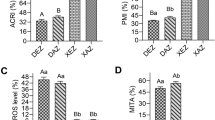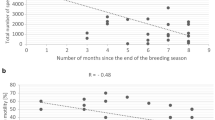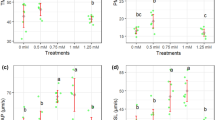Abstract
Electrolyte free mediums prepared with soybean lecithin-glycerol,Coenzyme Q10–glycerol and soybean lecithin-Coenzyme Q10-glycerol were inoculated separately into ligated cauda epididymides, equilibrated 2 h at 5 degree centigrade, wrapped with aluminium foils along with testis and freezed at -10 degree centigrade.Spermatozoan characters were evaluated 7 and 21 days after thawing at 38.5 degree centigrade in a water bath for 5 min. Spermatozoan characters were diminished gradually and significantly (P<0.001, P<0.05) between the mediums and observation days. Soybean lecithin-CoenzymeQ10-glycerol effectively protected spermatozoa against cold shock where spermatozoan progressive motility, livability, hypo-osmotic swelling positivity were 30.2 ± 0.62; 45.2 ± 0.82 and 41.6 ± 0.79 percent respectively on day 21. This new method is better than preservation of in-situ epididymal spermatozoa at 5 degree centigrade for a short duration. Therefore, present method can be adopted effectively in field conditions for transportation of freezed epididymides and for re-utilization of maximum functional gametes by artificial reproductive technologies to conserve valuable animals after postmortem / slaughter.
Similar content being viewed by others
Article PDF
Author information
Authors and Affiliations
Corresponding author
Rights and permissions
About this article
Cite this article
Datta, U., Chandrasekar, M., Hembram, M. et al. Development of a new method to preserve caprine cauda epididymal spermatozoa in-situ at -10 degrees Centigrade. Nat Prec (2009). https://doi.org/10.1038/npre.2009.3377.1
Received:
Accepted:
Published:
DOI: https://doi.org/10.1038/npre.2009.3377.1



